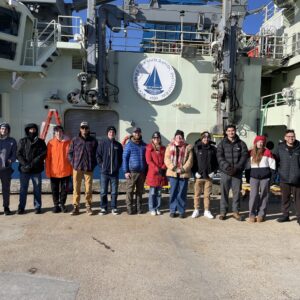
Entrance to Maple Swamp (Isabella Cantillano-Sanchez)
By Isabella Cantillano-Sanchez
One of my favorite things about Cape Cod, and New England in general, is the haunted and mystical quality that pervades it. This is what inspired me to join the Cape Cod Cryptids club here at Cape Cod Community College. For this semester’s first expedition we went to Maple Swamp in Sandwich to look for evidence of Pukwudgies, creatures whose existence I was unaware of before joining the club. Prior to our trip, I interviewed Professor Robin Smith-Johnson, an English professor here at Cape Cod Community College and author of two books about Cape Cod legends and lore. She accompanied the club on our expedition as the resident expert on Pukwudgies, and in our interview she offers background on the creatures as well as insight into Cape Cod’s connection to the supernatural.

Isabella Cantillano-Sanchez: What inspired you to write about legends and lore?
Robin Smith-Johnson: For many years, I was the newsroom librarian at the Cape Cod Times. In 2009, I started a blog for the paper called “Cape Rewind” that looked at stories from the Cape’s past. It was a fun task and one I did weekly until 2017. In the spring of 2015, I was approached by History Press to write a book about Cape Cod (they had found my blog online). I was intrigued by the idea of exploring Cape Cod history and agreed. One of the joys of my job was doing research for the reporters and editors. In doing my research, I often found little-known stories that I thought might interest our readers. I always felt like I had the history of this place at my fingertips and was happy to share my findings. After “Legends and Lore of Cape Cod” came out in June of 2016, I decided to write a companion book that became “Cape Cod Curiosities” (published in 2018). These books have truly been a labor of love.
Isabella Cantillano-Sanchez: How did you learn about Pukwudgies? Can you explain what they are?
Robin Smith-Johnson: I first heard about Pukwudgies when I did a talk at Tibcomb’s Books in Sandwich. A woman in the audience asked if I knew about the “little people” – I was intrigued and decided to do some research. As I wrote in “Cape Cod Curiosities,” “These two- to three-foot beings were sometimes described as smooth, gray and smelling of flowers – but also as being hairy-faced and having horns. They had oversized noses and long grasping fingers.” These mystical creatures were associated with Native American culture, including the Wampanoag on Cape Cod. They were known to be shapeshifters and mischievous, similar to fairies, elves and gnomes that reside in Europe. Another fun fact: The American version of Hogwarts (from the Harry Potter books) has four houses, like the ones in Britain. One of these houses is called Pukwudgie.
Isabella Cantillano-Sanchez: What do you think it is about Cape Cod that makes it such a center of activity for the supernatural?
Robin Smith-Johnson: Compared to the rest of the country, the Cape has been inhabited since the 1600s and, therefore, has a long and storied past. We are also rather isolated, so it makes sense that certain paranormal activity happens here. The many acres of marsh, dunes, and woods make a perfect refuge for creatures, both real and magical. Pukwudgies are also associated with Freetown State Forest. Paranormal experts believe that all of Southern New England is part of the “Bridgewater Triangle.”

We arrived at Maple Swamp late in the afternoon. The group consisted of club advisor Professor Tyler Daniels, Professor Robin Smith-Johnson, Liz Struhs, TJ Petronelli, and myself. The day was unseasonably pleasant, the usual cold winds and rain notably absent. Before embarking on our hike we consulted a map and Daniels readied his tablet to record our expedition for an episode of his radio show. Smith-Johnson and Struhs brought walking sticks for the hike, both giving off the air of experienced explorers. Petronelli assumed the role of navigator for the group, and we set off to look for evidence of Pukwudgies.
The trail proved relatively easy, even for an inexperienced hiker like myself, but we noticed a recurring pattern of fallen trees blocking our path. The trees seemed to grow larger and more difficult to step over the further we went. Smith-Johnson found a small object on the ground that she identified as a possible weapon wielded by Pukwudgies, its pointed end potentially carved by the tiny hands of the creatures. She pocketed this makeshift shiv, and we continued to the overlook where we paused to regroup.

After our brief rest, we continued our investigation as it began to grow darker and the noises of the forest began to grow louder. The sound of the frogs in the nearby swamp reached a fever pitch as we walked the winding trail. I heard creaking noises that seemed inexplicable. Our walk back to the parking lot seemed longer than our walk to the overlook, and I began to grow concerned that we’d gotten lost (or perhaps fallen victim to supernatural interference). Thankfully, we made it back safely and were able to have a final discussion about our findings. The artifact discovered by Smith-Johnson, the seemingly strategically placed trees, and the eerie sounds with no visible source could only have one explanation: there are Pukwudgies in Maple Swamp. As I departed, I was not only satisfied with the results of our investigation but also the time that I had gotten to spend in nature. Cape Cod is a beautiful place with many secrets to uncover, and I look forward to making more discoveries in the future.



